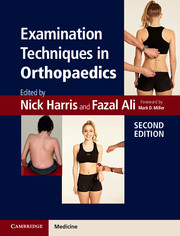Book contents
- Frontmatter
- Dedication
- Contents
- List of contributors
- Foreword
- Preface
- Acknowledgements
- 1 General principles of orthopaedic clinical examination
- 2 Examination of the shoulder
- 3 Examination of the elbow
- 4 Examination of the wrist
- 5 Examination of the hand
- 6 Examination of the peripheral nerves in the hand and upper limb
- 7 Examination of the adult spine
- 8 Examination of the hip
- 9 Examination of the knee
- 10 Examination of the foot and ankle
- 11 Examination of the brachial plexus
- 12 Orthopaedic examination techniques in children
- 13 Examination of the spine in childhood
- Index
- References
8 - Examination of the hip
- Frontmatter
- Dedication
- Contents
- List of contributors
- Foreword
- Preface
- Acknowledgements
- 1 General principles of orthopaedic clinical examination
- 2 Examination of the shoulder
- 3 Examination of the elbow
- 4 Examination of the wrist
- 5 Examination of the hand
- 6 Examination of the peripheral nerves in the hand and upper limb
- 7 Examination of the adult spine
- 8 Examination of the hip
- 9 Examination of the knee
- 10 Examination of the foot and ankle
- 11 Examination of the brachial plexus
- 12 Orthopaedic examination techniques in children
- 13 Examination of the spine in childhood
- Index
- References
Summary
History
A detailed clinical history and complete physical examination are mandatory in the assessment of the patient with a painful hip. Often a tentative diagnosis can be made on the history alone. The onset (acute or insidious), duration and severity of symptoms, as well as any earlier injury, are significant in any history taken. Examination and subsequent investigations allow for confirmation or modification of the presumptive diagnosis.
Presenting complaints in hip pathology may include pain, limp and stiffness. Patients may not complain of stiffness per se but of the disability produced by it (e.g. the inability to put socks on). In trying to evaluate a patient’s symptomatology it is important to know what effect, if any, the symptoms have on the patient’s ability to undertake activities of everyday living. Mechanical symptoms such as locking, clicking, catching or popping can also be presenting symptoms in their own right.
It is important to ask patients whether they have had any previous problems with their hips. Childhood conditions affecting the hip may cause symptoms in early adult life because of the development of secondary degenerative changes. In addition, a history of previous surgery is very important when contemplating further surgical procedures as consideration needs to be given to previous scars, the surgical approach, skeletal deformity and, in addition, the increased risk of infection with arthroplasty surgery.
- Type
- Chapter
- Information
- Examination Techniques in Orthopaedics , pp. 103 - 117Publisher: Cambridge University PressPrint publication year: 2014

